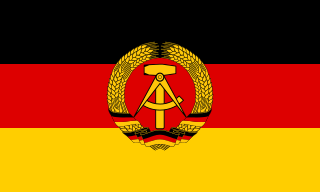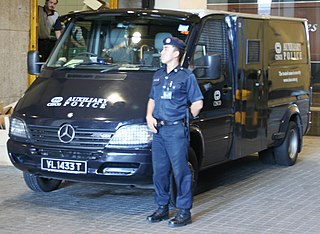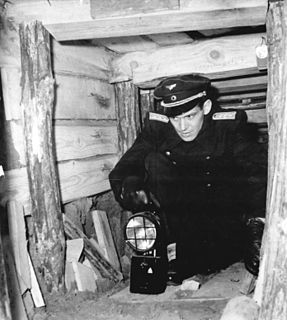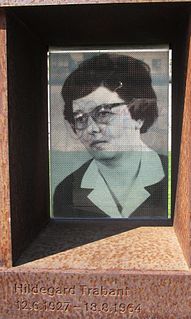
East Germany, officially the German Democratic Republic, was a state that existed from 1949 to 1990 in east Germany as part of the Eastern Bloc in the Cold War. Commonly described as a communist state, it described itself as a socialist "workers' and peasants' state". Its territory was administered and occupied by Soviet forces following the end of World War II—the Soviet occupation zone of the Potsdam Agreement, bounded on the east by the Oder-Neisse line. The Soviet zone surrounded West Berlin but did not include it and West Berlin remained outside the jurisdiction of the GDR. Most scholars and academics describe the GDR as a totalitarian dictatorship.

The Volksmarine was the naval force of the German Democratic Republic (GDR) from 1956 to 1990. The Volksmarine was one of the service branches of the National People's Army and primarily performed a coastal defence role along the GDR's Baltic Sea coastline and territorial waters.

German reunification was the process in 1990 by which the German Democratic Republic became part of the Federal Republic of Germany to form the reunited country of Germany.

The National People's Army were the armed forces of the German Democratic Republic (GDR) from 1956 to 1990.

The Inner German border was the border between the German Democratic Republic and the Federal Republic of Germany from 1949 to 1990. Not including the similar and physically separate Berlin Wall, the border was 1,393 kilometres long and ran from the Baltic Sea to Czechoslovakia.

Schießbefehl was the term in the German Democratic Republic for standing orders authorizing the use of lethal force by the Border Troops to prevent Republikflucht (defection) at the Inner German border from 1960 to 1989.

Auxiliary police, also called special police, are usually the part-time reserves of a regular police force. They may be armed or unarmed. They may be unpaid volunteers or paid members of the police service with which they are affiliated. The police powers auxiliary units may exercise vary from agency to agency; some have no or limited authority, while others may be accorded full police powers.

Republikflucht was the colloquial term in the German Democratic Republic for illegal emigration to West Germany, West Berlin, and non-Warsaw Pact countries; the official term was Ungesetzlicher Grenzübertritt. Republikflucht applied to both the 3.5 million Germans who migrated legally from the Soviet occupation zone and East Germany before the Berlin Wall was built on 13 August 1961, and the thousands who migrated illegally across the Iron Curtain until 23 December 1989. It has been estimated that 30,000 people left the GDR per year between 1984 and 1988, and up to 300,000 per year before the construction of the Berlin Wall in 1961.

Observation Post Alpha, OP Alpha, or Point Alpha was a Cold War observation post between Rasdorf, Hesse, in what was then West Germany and Geisa, Thuringia, then part of East Germany. The post overlooked part of the "Fulda Gap", which would have been a prime invasion route for Warsaw Pact forces had the Cold War erupted into actual warfare. It was abandoned by the military in 1991. Today, the "Point Alpha" memorial commemorates the observation point's four decades of existence. The memorial is dedicated to keeping it and a nearby section of the inner German border as reminders of the division of Germany and the confrontation between NATO and Warsaw Pact in the Cold War.
The Border checkpoint Helmstedt–Marienborn, named Grenzübergangsstelle Marienborn (GÜSt) by the German Democratic Republic (GDR), was the largest and most important border crossing on the Inner German border during the division of Germany. Due to its geographical location, allowing for the shortest land route between West Germany and West Berlin, most transit traffic to and from West Berlin used the Helmstedt-Marienborn crossing. Most travel routes from West Germany to East Germany and Poland also used this crossing. The border crossing existed from 1945 to 1990 and was situated near the East German village of Marienborn at the edge of the Lappwald. The crossing interrupted the Bundesautobahn 2 (A 2) between the junctions Helmstedt-Ost and Ostingersleben.

The Border Troops of the German Democratic Republic was the border guard of the German Democratic Republic (GDR) from 1946 to 1990.
The border guards of the inner German border comprised tens of thousands of military, paramilitary and civilian personnel from both East and West Germany, as well as from the United Kingdom, the United States and initially the Soviet Union.

The inner German border rapidly and unexpectedly fell in November 1989, along with the fall of the Berlin Wall. The event paved the way for the ultimate reunification of Germany just short of a year later.

The Ministry of National Defense was the chief administrative arm of the East German National People's Army. The MND was modeled on the Ministry of Defense of the Soviet Union. The headquarters of the Ministry was in Strausberg near East Berlin. The Guard Regiment Hugo Eberlein provided security and guard services to the Ministry. The Ministry also had its own publishing house, Military publishing house of the German Democratic Republic.

Hildegard Johanna Maria Trabant was an East German woman who became the fiftieth known person to die at the Berlin Wall. Trabant was shot and killed by East German border guards during a crossing attempt, one of only eight women victims of the Berlin Wall, and was the only escapee victim known to have a record of loyalty toward the East German regime.

Like the flags of West Germany, the Federal Republic of Germany, and the Weimar Republic, the flag of the German Democratic Republic showed the colors black, red and gold. The coat of arms, which, from 1959, was a hammer, compass and wreath of corn, was located in the middle of the color red.
The Freiwilliger Helfer der Volkspolizei was an auxiliary police service in East Germany from 1952 to 1990.
René Bochmann is a German politician for the right-wing Alternative for Germany and since 2021 member of the Deutsche Bundestag, the German federal diet.













